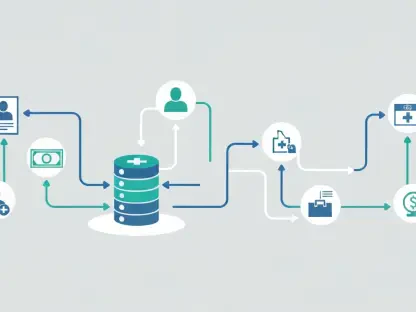Embedded finance is making waves across various industries, particularly for Payment Facilitators (PayFacs), Independent Software Vendors (ISVs), and online marketplaces. This integration of financial services directly into non-financial platforms has revolutionized the way businesses handle payments, promising not just increased efficiency but also substantial revenue gains. The seamless blending of banking, lending, and transaction services into everyday business operations allows these companies to offer their users more convenient and comprehensive financial services, creating new opportunities for growth and engagement.
The Role of PayFacs in Transforming Commerce
Payment Facilitators, commonly known as PayFacs, have reshaped the commercial landscape. Historically, ISVs and online marketplaces were adept at offering products and services but struggled with the complexities of payment processing. PayFacs have emerged as critical players, filling this gap by streamlining payment processes and enabling these platforms to handle transactions more effectively. This change is significant as it allows companies to focus on their main offerings without being bogged down by the intricacies of payment handling.
By offering merchant accounts, anti-fraud measures, and compliance with financial regulations, PayFacs allow ISVs and marketplaces to focus on core business operations. This shift has made it easier for smaller companies to enter the market and compete with larger, more established players. The role of PayFacs goes beyond simply facilitating transactions. They also offer valuable services like customer support, seamless integration with existing systems, and advanced analytics, enabling platforms to optimize their operations and improve customer satisfaction. In an increasingly competitive marketplace, these advantages can be critical for emerging companies to gain a foothold and thrive.
The Evolution and Impact of Embedded Finance
Embedded finance refers to the integration of financial services like banking and credit directly into retail platforms and software solutions. This trend is transforming commerce by creating new revenue channels and enhancing user experiences. For instance, ISVs and marketplaces that incorporate embedded finance can offer services like instant credit approval, lending, and insurance seamlessly within their platforms, making these services more accessible to their users. This integration simplifies the user experience and reduces friction, encouraging more frequent and higher-value transactions.
The most striking feature of embedded finance is its ability to generate additional revenue streams. By integrating financial services, companies can charge fees for transactions, lending, and other financial products. This has proven to be a significant revenue driver, particularly for platforms that operate with high transaction volumes. Beyond generating revenue, embedded finance features enhance user engagement and retention. When users can access comprehensive financial services without needing to leave the platform, their overall experience becomes smoother and more satisfying, leading to higher loyalty and repeat business. For ISVs and marketplaces, this translates into sustained growth and greater financial stability.
Revenue Generation through Embedded Finance
For ISVs and online marketplaces, integrating embedded finance goes beyond simplifying payment acceptance; it has become a substantial source of revenue. Businesses that utilize these features report higher revenue from payment processing fees, making embedded finance an essential component of their revenue models. Notably, platforms that handle high transaction volumes benefit the most, as they can capitalize on numerous micro-transactions which, collectively, constitute a significant income stream.
Moreover, embedded finance boosts customer retention and satisfaction by offering more convenient and comprehensive services. Customers benefit from quicker transaction processes and access to immediate credit, making these platforms more attractive and user-friendly. The added convenience translates into increased user activity and higher transaction volumes, further driving revenue growth for the platforms. Additionally, embedded finance opens up opportunities for cross-selling and up-selling financial products, thereby diversifying revenue streams and enhancing the overall profitability of the platform.
Innovations Driving Growth: BNPL and Loyalty Programs
One of the innovative features that embedded finance has popularized is Buy Now, Pay Later (BNPL). This offering allows customers to make purchases and pay for them in installments, providing financial flexibility. BNPL has been widely adopted by ISVs and marketplaces because it drives sales and improves conversion rates. Customers appreciate the ability to defer payment, which can make higher-priced products more accessible and thereby increase the average transaction value.
Similarly, loyalty and rewards programs integrated within financial services platforms have proved to be effective in enhancing customer engagement. These programs incentivize repeat business and foster customer loyalty by offering rewards for transactions, thereby increasing overall sales and customer loyalty. For businesses, the integration of loyalty programs within their financial services offerings not only boosts customer retention but also allows them to gather valuable data on user behavior, which can be used to tailor marketing strategies and further enhance customer satisfaction.
Survey Insights on Embedded Finance Adoption
A comprehensive survey conducted by PYMNTS Intelligence between May 28 and July 30, 2024, sheds light on how PayFacs, ISVs, and marketplaces manage payment and embedded lending processes. The survey, which included insights from 280 executives, reveals that the adoption of embedded finance is not just a trend but a strategic imperative. The data indicates that firms integrating both payment acceptance and embedded finance features are seeing significant growth in revenue. This trend points to a consensus among industry leaders that embedded finance is the future of commerce, providing a vital edge over competitors who have not yet adopted these technologies.
The survey data underscores the importance of embedded finance in driving business success. It reveals that companies focusing on integrating financial services within their platforms report higher levels of customer satisfaction and retention. This aligns with the broader industry trend toward improving user experiences by offering seamless, integrated financial solutions. The positive impact of embedded finance is clear, and businesses that leverage these technologies are better positioned to capitalize on new market opportunities and achieve long-term growth.
The Role of PayFacs in Navigating Challenges
While embedded finance offers numerous benefits, it also presents challenges such as regulatory compliance and security risks. PayFacs play an indispensable role in helping ISVs and marketplaces navigate these challenges. They provide the necessary infrastructure and expertise to ensure that financial transactions are secure, compliant, and efficient. By leveraging the services of PayFacs, businesses can mitigate the risks associated with embedded finance and focus on their core operations without the added burden of managing complex financial regulations.
PayFacs assist smaller firms in overcoming regulatory hurdles, which can be particularly daunting without specialized knowledge. This support makes it easier for businesses to adopt embedded finance solutions, thereby leveling the playing field for smaller market players. PayFacs offer robust security measures, including encryption, fraud detection, and risk management, which are critical for protecting sensitive financial data. These measures are essential for maintaining customer trust and ensuring the smooth operation of financial services within the platform.
Market Expansion through Embedded Finance
Embedded finance is creating significant changes across numerous industries, especially for Payment Facilitators (PayFacs), Independent Software Vendors (ISVs), and online marketplaces. By weaving financial services directly into non-financial platforms, businesses are experiencing a transformative shift in how they manage payments. This approach not only boosts efficiency but also promises notable revenue increases.
Integrating banking, lending, and transaction services within everyday business functions allows companies to provide users with more convenient and comprehensive financial solutions. For instance, PayFacs can now embed payment solutions directly into their offerings, making it easier for users to process transactions without needing to leave the platform. Similarly, ISVs can enhance their software products by adding built-in financial features, making their services more appealing and competitive.
Online marketplaces benefit by offering embedded payment options that streamline the purchasing process, fostering a more seamless user experience. Ultimately, embedded finance opens up new avenues for growth and user engagement by making financial transactions more accessible and efficient. This integration not only meets the current demands of a fast-paced market but also sets the stage for future innovations in financial technology.









